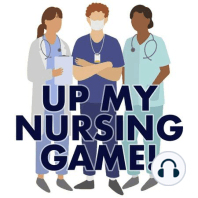54 min listen

How to Care for Pregnant and Lactating Patients in Non-Obstetric Departments with Dr. Michelle Solone
How to Care for Pregnant and Lactating Patients in Non-Obstetric Departments with Dr. Michelle Solone
ratings:
Length:
59 minutes
Released:
Apr 25, 2021
Format:
Podcast episode
Description
Pregnant and breastfeeding patients aren't always hospitalized for obstetric reasons and can be placed throughout the hospital. Dr. Michelle Solone, OBGYN talks to us about how we can assess these patients, what to look out for, and how nurses can promote pumping and breastfeeding during a hospitalization.Common reasons for non-OBGYN related hospitalization for pregnant patients:Medical: Kidney Stones, Chemo, Pyelonephritis, Cardiac ConditionsSurgical: Cholecystitis, AppendicitisTraumaWhich floor does the Pregnant Patient receive care on?Less than 20 weeks → regular medical floor20 weeks & up → Labor & Delivery FloorSituational Examples: L&D Nurses don't interpret EKG's, which will influence which floor a patient can be assigned → CCU/ICUED for asthma exacerbation, traumasRespiratory Distress/IV Drip Monitoring →need ICU nurse with L&D Nurse present to monitor babyPhysiologic Differences of Pregnant PatientsIncreased Blood Volume which can lead to dilutional anemia (ex: Hct 34), due to plasma>RBCsIncreased Cardiac Output and decreased vascular resistance (↓BP) CPR: Left lateral decubitus positioning or Left Uterine displacement for CPR over 20 weeks →Have mom supine, and have a coworker push the uterus about 2 inches over to the Left side for circulation returnIncreased WBCsDecreased lung capacity, but increased tidal volume (RR should be same)Increased risk for VTE Nursing Interventions: SCD's, mobilization, sleep on left sideMedical Intervention: Lovenox, HeparinIncreased GFR →some medications may need adjustments/labsAssessment ABC's of PregnancyA. Amniotic FluidB. Bleeding (never normal, need OBGYN at bedside)C. Contractions/Abdominal PainD. DysuriaE. Edema (DVT or Pre-Eclampsia)F. Fetal MovementMedications and Imaging in PregnancyThere is a fear of giving moms pain medications, but most narcotics are safe in short term, such as with kidney stones. Chronic use would be of concern. Antibiotics such as Vancomycin and Ampicillin are very common for the treatment of infection in pregnant patientsImaging is safe Preference →ultrasound to avoid radiation, followed by MRI (no gadolinium) if neededCT (with or without contrast) is also safeCare of the Postpartum and Lactating PatientImportant: Advocate for breastfeeding and Pumping! Get a Pump in the room early on!Save ALL milk → DON'T DUMP Unnecessarily Label milk to later review with MD if safe for babyWhat meds are compatible with breastfeeding? Almost all medications are compatible with breastfeedingNotable exception: Codeine/Tramadol (such as Tylenol with Codeine)Regular Tylenol and Motrin safe for Postpartum PatientsPhysiological Changes in Postpartum Fluid Shifts: all blood from uterus rush and return back to heart → flash pulmonary edema, fluid overload within 24 hrs after deliveryPreeclampsia may present after deliveryAnemia →PP mom may need blood transfusions/iron
Released:
Apr 25, 2021
Format:
Podcast episode
Titles in the series (72)
#7 Palliative Care: Goals of Care Discussion by Up My Nursing Game